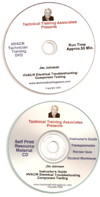
|
| David Holdorf, Taco's Residential Trainer & Rep Training Manager, Eastern Region (left) and Steve Anderson, Account Manager for F.W. Webb’s Methuen Office, discuss integration of the hydronic system’s key components. |
Late last year, Mike Casey, of KC Plumbing & Heating, was involved with an extensive oil-to-gas boiler retrofit in Westwood, Mass. that also included a second-story addition and installation of in-floor radiant. The homeowners wanted an “ultimate efficiency and ultimate comfort” system that resulted in a wide array of state-of-the art products being installed, some of which Casey hadn’t used before.
Web-enabled thermostats, smart pumps, radiant panel systems and mixing valves with outdoor reset were just a few items used in conjunction with a condensing boiler and buffer tank to meet the goal.
During the design phase, Casey leaned on rep firm Emerson Swan and New England wholesaler, F.W. Webb for product expertise. Before the retrofit and addition, the 1,850 square foot, ranch-style home was heated using two zones of fin-tube baseboard and a 125 MBH boiler.
Taco’s FloPro Designer software was used to calculate the existing heat load at 58,200 BTU/H. With the extra load of the second story addition, the new system was designed to provide a total of 85,400 BTUs via radiant while also providing DHW. Ultimately, the retrofit would save the Kaiser family more than $1,000 per year in fuel consumption, despite the additional living space and DHW production.
As the plans progressed and the cutting-edge product list grew, Joe Ruggiero,heating products managerat F.W. Webb, realized that the jobsite was the perfect opportunity to invite several manufacturers out to conduct a walk-through training session. The goal was to educate Webb employees and local contractors on the use of new technology.
“Residential products are advancing as fast as technology in any other sectors,” said Ruggiero. “Keeping abreast of it can be daunting for everyone in the industry, not just installers. We thought this would be a unique opportunity to brush up.”
As the project was nearing completion in January, Kevin Sullivan, of ecobee, Rich McNally, sales manager – HVAC Eastern Region for Watts Water, and David Holdorf, Taco's residential trainer & rep training manager spent the day at the home demonstrating product use and answering questions. Emerson Swan’s Christian Frattasio, who played a part in the system’s design, was also on site.
Two Types of Radiant
The homeowners wanted to abandon the fin-tube, preferring toheat the home with in-floor radiant. For the most efficient and comfortable results, two different tubing systems would be needed to address the variation between the new and existing portions of the home. This meant two supply water temperatures.
Downstairs, the baseboard was removed and Watts Radiant Onix EPDM tubing was stapled into joist bays with access from the basement. “If it’s a staple-up job, I prefer EPDM tubing over PEX because of the flexibility,” said Casey. “It’s not like wrestling a python in tight quarters.” The staple-up portion is designed to use 140°F supply water.
Some areas of the main floor are built over shallow crawlspace. Here, and across the entire upstairs addition, new Watts Radiant SmartTrac radiant panel system was installed over the OSB subfloor.
Made almost entirely of recycled material, SmartTrac offers all the benefits of a poured gypcrete slab, with less weight and thickness and no drying time. The system works with all floor coverings.
“The panels install quickly, making them perfect for a roof-off project,” said McNally, while demonstrating its use to general contractor Jim Kane and Webb employees. “After the material is down, you simply walk three-eighths-inch PEX or PERT into the grooves.” This portion of the system averages 125°F supply water.
Near Boiler Piping
A 105 MBH, Burnham Alpine modulating boiler is used to supply heat and domestic hot water. In order to do so, Casey needed a way to supply three water temperatures, two of which vary depending on outdoor temperature.
The boiler provides 180°F to the primary loop and buffer tank. Between the buffer tank and each of the radiant supply manifolds is a three-way Taco iSeries mixing valve.
“With a full-featured outdoor reset control built into the actuator, the valves modulate based on the outdoor temperature and the required supply temperature,” said Holdorf. “That means year-round comfort control, efficiency and temperature delivery for every zone by supplying optimal water temperature.”
To achieve the “ultimate comfort” stipulation, the system includes some very small zones, two of which are bathrooms. Micro zones are challenging from a short-cycling standpoint. Condensing boilers don’t have a water jacket that can satisfy a small load without firing the unit. Additionally, if supply and return water temperatures to a high-efficiency boiler aren’t far enough apart, it won’t condense, meaning it’ll operate at traditional boiler efficiencies instead of the 95 percent AFUE that it’s designed for.
Casey decided that installing a buffer tank would help flywheel the system through small calls for heat without firing the Alpine. The 30-gallon Boiler Buddy buffer tank has enough thermal mass to satisfy the home’s smallest zones in normal conditions. It also extends the input cycle of the boiler whenever it does fire.
While tiny zones increase comfort and controllability, they present another challenge beyond boiler short cycling: over pumping. The system needed pumps that could accommodate a widely-varying GPM demand. Casey installed an ECM-driven, variable-speed Taco Bumble Bee circulator.
“We’re going to great lengths to achieve the highest level of efficiency possible,” said Casey. “By choosing ECM, variable speed pumps, the homeowner enjoys electric and fuel savings. And the Bumble Bee pumps provide the perfect flow rate by maintaining the 20°F delta-T we designed for.”
Stretching Comfort and Efficiency
Part of F.W. Webb’s interest in holding an open house training day was to familiarize employees and customers with products that help meet stringent efficiency requirements in parts of New England.
In Massachusetts, towns can remain on the state’s base energy code or adopt the Stretch Appendix to the Building Energy Code as their requirement, which means achieving approximately 20 percent higher efficiency in new buildings. The stretch code was adopted in Westwood, where the project took place.
DHW recirculation can play a key role in meeting guidelines. Taco’sSmartPlus hot water recirc system was installed during the retrofit. The pump “learns” the family’s water use patterns. This not only keeps hot water at the tap for use at a moment’s notice, but the average family of four can save 12,000 gallons of fresh water each year. But recirc pumps aren’t the only adaptive technology used at Kaisers’.
“Like most families with young kids, we’re pretty tech-savvy,” said Kaiser. “We wanted precise control of the climate in the house regardless of where we are.” Almost every room in the house is individually controlled by web-enabled ecobee® Smart thermostats. This offers them comfort while they’re home and energy savings when they’re not.
Homeowners can manually input setpoint for times and days of the week, or use the Smart t-stat’s calendar. Either way, the result is optimum comfort and efficiency. Ecobee products come out of the box ready to connect to the home’s Wi-Fi, just like a phone or tablet, and there’s no monthly or annual fee.
“This open house training day proved to be a casual way to touch up on equipment expertise, while also getting some great face time with both manufacturers and installer,” said Steve Anderson,account manager for F.W. Webb out of the Methuen office. “We’ll be looking for an opportunity to do it again in the future.”







